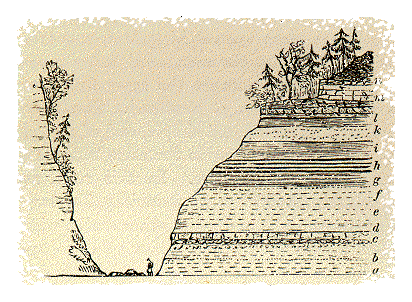 The study of ancient reefs requires a basic understanding of sedimentary rocks. Clastic sedimentary rocks form by the accumulation of sediment particles eroded from older rocks, and they represent mud, sand or gravel that has hardened into rock. Carbonate sedimentary rocks, including limestone and dolostone, form when organic activity or inorganic precipitation extracts carbonate from seawater to form a sediment composed of calcium carbonate or calcium-magnesium carbonate. The study of ancient reefs requires a basic understanding of sedimentary rocks. Clastic sedimentary rocks form by the accumulation of sediment particles eroded from older rocks, and they represent mud, sand or gravel that has hardened into rock. Carbonate sedimentary rocks, including limestone and dolostone, form when organic activity or inorganic precipitation extracts carbonate from seawater to form a sediment composed of calcium carbonate or calcium-magnesium carbonate.
 Most sedimentary rocks are deposited under water as layers, which can also be called beds or strata. Most sedimentary rocks are deposited under water as layers, which can also be called beds or strata.
|
|
An important aspect of this process is the principle of superposition. This principle states that, in a "stack" of sedimentary layers, the oldest layer is at the bottom of the stack and the youngest layer is at the top.
|

Sketch from Sir Roderick Murchison's famous book, SILURIA, published in 1859, demonstrating the principle of superposition. The sketch shows beds of horizontal sedimentary rocks stacked on top of each other. The bed at the bottom of the sequence ("a") was deposited first, and therefore is the oldest bed in the sequence. Bed "n" is the youngest bed. Note the person in the stream valley for scale.
|
 Any sedimentary layer or bed can be assigned an "older" or "younger" age relative to the layers below and above it. This principle is critical as the basis for the relative geologic time scale. Any sedimentary layer or bed can be assigned an "older" or "younger" age relative to the layers below and above it. This principle is critical as the basis for the relative geologic time scale.
 Another important aspect of sedimentary rocks is the principle of uniformitarianism, often summarized as "the present is the key to the past." In its most general form, this principle tells us to interpret geologic features in terms of things or processes that we can see today. For example, a geologist who finds a mound-like rock structure with abundant fossil corals is faced with the problem of how it formed. Modern corals live only in seawater, so a marine origin can be inferred for the structure. Further comparisons of the structure with modern marine environments would reveal its similarity to coral-built reefs of tropical areas. This is, in fact, how geologists recognized the presence of ancient reefs in Wisconsin as early as the 1850s. Another important aspect of sedimentary rocks is the principle of uniformitarianism, often summarized as "the present is the key to the past." In its most general form, this principle tells us to interpret geologic features in terms of things or processes that we can see today. For example, a geologist who finds a mound-like rock structure with abundant fossil corals is faced with the problem of how it formed. Modern corals live only in seawater, so a marine origin can be inferred for the structure. Further comparisons of the structure with modern marine environments would reveal its similarity to coral-built reefs of tropical areas. This is, in fact, how geologists recognized the presence of ancient reefs in Wisconsin as early as the 1850s.
|


